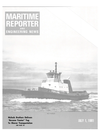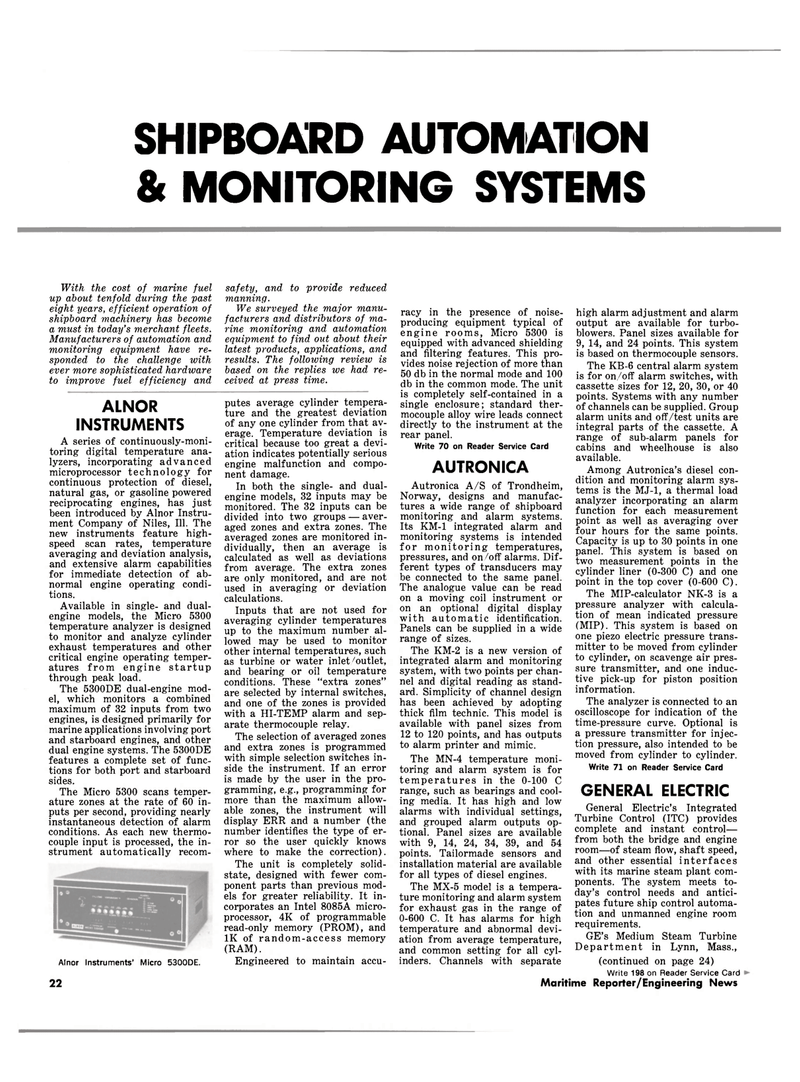
Page 20: of Maritime Reporter Magazine (July 1981)
Read this page in Pdf, Flash or Html5 edition of July 1981 Maritime Reporter Magazine
SHIPBOARD AUTOMATION & MONITORING SYSTEMS
With the cost of marine fuel up about tenfold during the vast eight years, efficient operation of shipboard machinery has become a must in today's merchant fleets.
Manufacturers of automation and monitoring equipment have re- sponded to the challenge with ever more sophisticated hardware to improve fuel efficiency and safety, and to provide reduced manning.
We surveyed the major manu- facturers and distributors of ma- rine monitoring and automation equipment to find out about their latest products, applications, and results. The follotving review is based on the replies we had re- ceived at press time.
ALNOR
INSTRUMENTS
A series of continuously-moni- toring digital temperature ana- lyzers, incorporating advanced microprocessor technology for continuous protection of diesel, natural gas, or gasoline powered reciprocating engines, has just been introduced by Alnor Instru- ment Company of Niles, 111. The new instruments feature high- speed scan rates, temperature averaging and deviation analysis, and extensive alarm capabilities for immediate detection of ab- normal engine operating condi- tions.
Available in single- and dual- engine models, the Micro 5300 temperature analyzer is designed to monitor and analyze cylinder exhaust temperatures and other critical engine operating temper- atures from engine startup through peak load.
The 5300DE dual-engine mod- el, which monitors a combined maximum of 32 inputs from two engines, is designed primarily for marine applications involving port and starboard engines, and other dual engine systems. The 5300DE features a complete set of func- tions for both port and starboard sides.
The Micro 5300 scans temper- ature zones at the rate of 60 in- puts per second, providing nearly instantaneous detection of alarm conditions. As each new thermo- couple input is processed, the in- strument automatically recom-
Alnor Instruments' Micro 5300DE. 22 putes average cylinder tempera- ture and the greatest deviation of any one cylinder from that av- erage. Temperature deviation is critical because too great a devi- ation indicates potentially serious engine malfunction and compo- nent damage.
In both the single- and dual- engine models, 32 inputs may be monitored. The 32 inputs can be divided into two groups — aver- aged zones and extra zones. The averaged zones are monitored in- dividually, then an average is calculated as well as deviations from average. The extra zones are only monitored, and are not used in averaging or deviation calculations.
Inputs that are not used for averaging cylinder temperatures up to the maximum number al- lowed may be used to monitor other internal temperatures, such as turbine or water inlet/outlet, and bearing or oil temperature conditions. These "extra zones" are selected by internal switches, and one of the zones is provided with a HI-TEMP alarm and sep- arate thermocouple relay.
The selection of averaged zones and extra zones is programmed with simple selection switches in- side the instrument. If an error is made by the user in the pro- gramming, e.g., programming for more than the maximum allow- able zones, the instrument will display ERR and a number (the number identifies the type of er- ror so the user quickly knows where to make the correction).
The unit is completely solid- state, designed with fewer com- ponent parts than previous mod- els for greater reliability. It in- corporates an Intel 8085A micro- processor, 4K of programmable read-only memory (PROM), and
IK of random-access memory (RAM).
Engineered to maintain accu- racy in the presence of noise- producing equipment typical of engine rooms, Micro 5300 is equipped with advanced shielding and filtering features. This pro- vides noise rejection of more than 50 db in the normal mode and 100 db in the common mode. The unit is completely self-contained in a single enclosure; standard ther- mocouple alloy wire leads connect directly to the instrument at the rear panel.
Write 70 on Reader Service Card
AUTRONICA
Autronica A/S of Trondheim,
Norway, designs and manufac- tures a wide range of shipboard monitoring and alarm systems.
Its KM-1 integrated alarm and monitoring systems is intended for monitoring temperatures, pressures, and on/off alarms. Dif- ferent types of transducers may be connected to the same panel.
The analogue value can be read on a moving coil instrument or on an optional digital display with automatic identification.
Panels can be supplied in a wide range of sizes.
The KM-2 is a new version of integrated alarm and monitoring system, with two points per chan- nel and digital reading as stand- ard. Simplicity of channel design has been achieved by adopting thick film technic. This model is available with panel sizes from 12 to 120 points, and has outputs to alarm printer and mimic.
The MN-4 temperature moni- toring and alarm system is for temperatures in the 0-100 C range, such as bearings and cool- ing media. It has high and low alarms with individual settings, and grouped alarm outputs op- tional. Panel sizes are available with 9, 14, 24, 34, 39, and 54 points. Tailormade sensors and installation material are available for all types of diesel engines.
The MX-5 model is a tempera- ture monitoring and alarm system for exhaust gas in the range of 0-600 C. It has alarms for high temperature and abnormal devi- ation from average temperature, and common setting for all cyl- inders. Channels with separate high alarm adjustment and alarm output are available for turbo- blowers. Panel sizes available for 9, 14, and 24 points. This system is based on thermocouple sensors.
The KB-6 central alarm system is for on/off alarm switches, with cassette sizes for 12, 20, 30, or 40 points. Systems with any number of channels can be supplied. Group alarm units and off/test units are integral parts of the cassette. A range of sub-alarm panels for cabins and wheelhouse is also available.
Among Autronica's diesel con- dition and monitoring alarm sys- tems is the MJ-1, a thermal load analyzer incorporating an alarm function for each measurement point as well as averaging over four hours for the same points.
Capacity is up to 30 points in one panel. This system is based on two measurement points in the cylinder liner (0-300 C) and one point in the top cover (0-600 C).
The MlP-calculator NK-3 is a pressure analyzer with calcula- tion of mean indicated pressure (MIP). This system is based on one piezo electric pressure trans- mitter to be moved from cylinder to cylinder, on scavenge air pres- sure transmitter, and one induc- tive pick-up for piston position information.
The analyzer is connected to an oscilloscope for indication of the time-pressure curve. Optional is a pressure transmitter for injec- tion pressure, also intended to be moved from cylinder to cylinder.
Write 71 on Reader Service Card
GENERAL ELECTRIC
General Electric's Integrated
Turbine Control (ITC) provides complete and instant control— from both the bridge and engine room—of steam flow, shaft speed, and other essential interfaces with its marine steam plant com- ponents. The system meets to- day's control needs and antici- pates future ship control automa- tion and unmanned engine room requirements.
GE's Medium Steam Turbine
Department in Lynn, Mass., (continued on page 24)
Write 198 on Reader Service Card
Maritime Reporter/Engineering News

 19
19

 21
21
